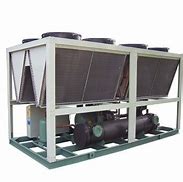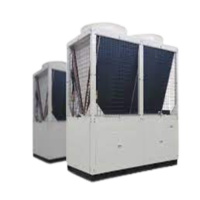WATER COOLED WATER CHILLERS
Water-cooled chillers are a type of chiller that uses water to cool refrigerant. The refrigerant is then circulated through a cooling system to cool the air in your building. Water-cooled chillers are typically more efficient than air-cooled chillers, but they require a cooling tower to operate.
Water-cooled chillers are made from a variety of materials, including steel, aluminum, copper, brass, stainless steel, and plastic. The specific materials used will vary depending on the manufacturer and the specific application.


Water-cooled chillers are typically composed of the following components:
- Compressor: The compressor compresses the refrigerant gas, which increases its temperature and allows it to absorb more heat.
- Condenser: The condenser is where the hot refrigerant gas releases its heat to the cooling water.
- Evaporator: The evaporator is where the cool refrigerant gas absorbs heat from the water that is being cooled.
- Expansion valve: The expansion valve reduces the pressure of the refrigerant gas, which causes it to cool and condense.
- Pump: The pump circulates the cooling water through the condenser and evaporator.
- Controls: The controls regulate the operation of the chiller, including the compressor, condenser, evaporator, and pump.
However, water-cooled chillers also have some disadvantages, including:
- Cost: Water-cooled chillers are more expensive to purchase and install than air-cooled chillers.
- Complexity: Water-cooled chillers are more complex than air-cooled chillers and require more maintenance.
- Space requirements: Water-cooled chillers require more space than air-cooled chillers because they need to accommodate a cooling tower.
If you are looking for a high-efficiency chiller that can handle large cooling loads, then a water-cooled chiller is a good option. However, if you are on a budget or have limited space, then an air-cooled chiller may be a better choice.
Water-cooled chillers are complex pieces of equipment, but they are essential for cooling many types of buildings and facilities. By understanding the components used in water-cooled chillers, you can better understand how they work and how to keep them running efficiently.
Compressor: The compressor is the heart of the chiller. It compresses the refrigerant gas, which increases its temperature and allows it to absorb more heat.
Condenser: The condenser is where the hot refrigerant gas releases its heat to the cooling water. The condenser is typically made of copper or aluminum coils.
Evaporator: The evaporator is where the cool refrigerant gas absorbs heat from the water that is being cooled. The evaporator is also typically made of copper or aluminum coils.
Expansion valve: The expansion valve reduces the pressure of the refrigerant gas, which causes it to cool and condense.
Pump: The pump circulates the cooling water through the condenser and evaporator.
Controls: The controls regulate the operation of the chiller, including the compressor, condenser, evaporator, and pump.
In addition to these basic components, water-cooled chillers may also include other features, such as:
Alarms: Alarms alert the operator to potential problems with the chiller.
Cooling tower: The cooling tower is where the hot cooling water from the condenser is cooled down before it is recirculated.
Drains: Drains allow for the removal of condensed water from the chiller.
Filters: Filters remove impurities from the cooling water, which helps to protect the chiller from damage.
Monitoring systems: Monitoring systems allow the operator to track the performance of the chiller and identify any potential problems early on.
Here are some specific applications where water-cooled chillers are commonly used:
Data centers: Data centers require a lot of cooling to keep their servers running efficiently. Water-cooled chillers are ideal for this application because they can provide the high cooling capacity that is needed.
Manufacturing facilities: Manufacturing facilities often have high cooling requirements due to the heat generated by machinery and processes. Water-cooled chillers can provide the reliable and efficient cooling that is needed in these applications.
Commercial buildings: Commercial buildings such as office towers, hotels, and hospitals often have large cooling requirements. Water-cooled chillers can provide the cooling capacity and efficiency that is needed in these applications.
